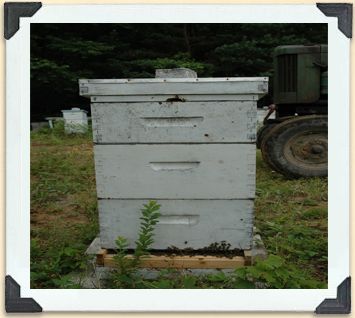Life in a Hive

The exterior of a Langstroth hive.
© University of Guelph: Burton Noble Gates Collection
Floor Plan
A common manufactured beehive consists of two deep boxes, with ten frames each that are used as the brood chamber. This is where the queen lays her eggs and the larvae are looked after. On top of the two hive boxes, the beekeeper adds "honey supers," which are boxes with ten frames each meant for honey storage. The number of supers added depends on the amount of honey being made by the bees.
The beekeeper sometimes places a queen excluder (a type of screen) between the brood boxes and the honey supers to stop the queen from going into the honey supers and laying eggs. The top of the hive has a removable cover so that the beekeeper can inspect it.




